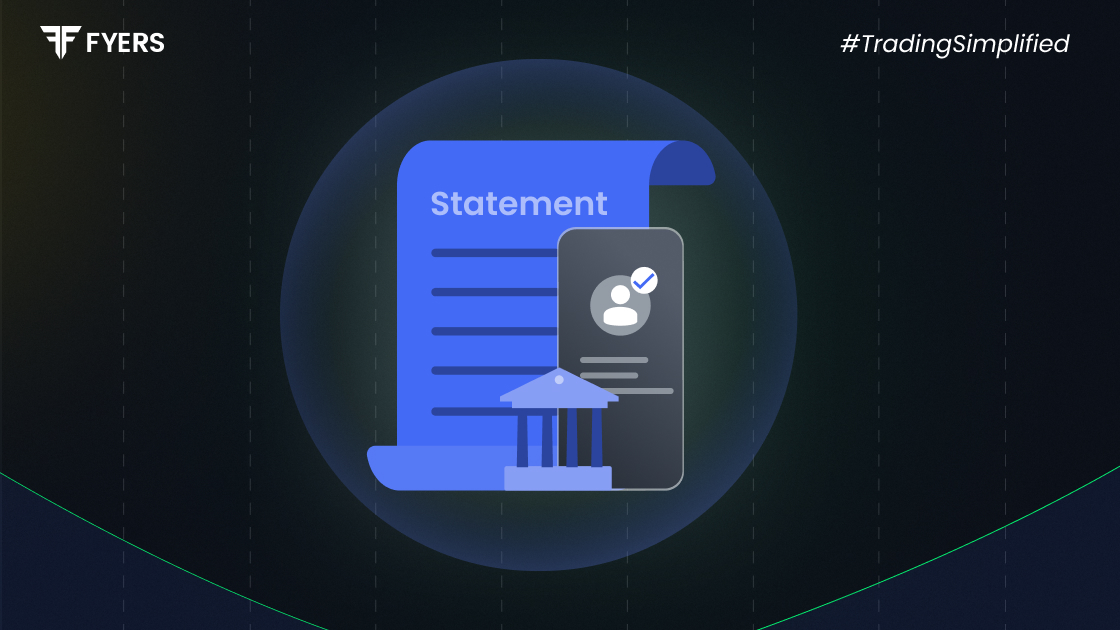

 30 Jul, 2021
30 Jul, 2021
 4 mins read
4 mins read

If you invest in shares, ETFs, or mutual funds through a Demat account, it’s essential to understand the documentation that tracks your portfolio. One of the most important documents is the Demat account holding statement. This statement provides a snapshot of all the securities held in your account at a given time.
This guide explains what a Demat holding statement is, how it differs from a transaction statement, how to download it, and why reviewing it regularly is crucial for all investors.
A Demat account holding statement is a detailed report that reflects the current holdings of an investor in their Demat account. Just like a bank passbook shows your savings, a holding statement shows your securities.
It includes:
Equity shares
Bonds
Mutual fund units
ETFs
Government securities (G-Secs)
Other financial instruments in dematerialised form
The statement is issued by your Depository Participant (DP)—such as FYERS, Angel One, Zerodha, or Groww—and is based on data maintained by depositories like NSDL or CDSL.
A typical statement of Demat holding includes the following details:
Investor’s Name and DP ID
Demat Account Number (BO ID)
ISIN (International Securities Identification Number) of each security
Security Name and Quantity Held
Free vs Locked-in Shares – some shares might be under lock-in periods
Date of Holding
Valuation – some statements show the market value of each holding based on the latest price
These details help you verify the accuracy of your investments and track your portfolio at a glance.
Many investors search for “Demat account holding statement download” options, especially during tax season or when reviewing investments.
Here’s a quick step-by-step process for downloading the latest Demat account holding statement:
Visit cdslindia.com
Click on ‘Login to – Easi / Easiest’
Enter your credentials (BO ID and password)
Go to ‘Holdings’ tab to view your current holdings
Click ‘Download’ or ‘Export to PDF’
Visit nsdl.co.in
Use the ‘NSDL CAS login’ option if registered
Access your statement via the Consolidated Account Statement (CAS)
Download or request email delivery
You can also download it directly from your broker’s dashboard or mobile app (e.g., FYERS, Groww, or Angel One).
Investors often confuse the Demat holding statement with a transaction statement, but both serve distinct purposes:
|
Feature |
Demat Holding Statement |
Demat Transaction Statement |
|---|---|---|
|
Purpose |
Shows current securities in your account |
Shows all buy/sell transactions |
|
Frequency |
Can be downloaded anytime |
Typically issued monthly/quarterly |
|
Content |
Holdings as on a particular date |
All credits and debits in the Demat account |
|
Use Case |
Portfolio tracking |
Trade verification and audit |
So, if you want to check what you own, refer to the holding statement. To track what you’ve done, use the transaction statement.
Your Demat holding statement is a vital document for several reasons:
Portfolio Tracking: It helps monitor your investments across asset classes.
Tax Filing: You may need it to compute capital gains for ITR filing.
Reconciliation: Helps detect errors in credit of shares after IPOs, rights issues, or stock splits.
Loan Against Securities: Required when pledging shares as collateral.
Proof of Ownership: Serves as evidence of your equity and mutual fund investments.
Being informed about your holdings ensures better financial control and planning.
It’s advisable to review your Demat account holding statement:
Monthly – especially if you actively invest or trade
Quarterly – if you invest passively
During Tax Filing Season – to match with gains and dividends
After Major Events – such as IPO allotment, bonus share credit, or fund redemptions
Regular checks help ensure that all transactions are accurately reflected and there are no unauthorised changes in your holdings.
While most statements are accurate, occasional discrepancies may arise. Here are some common issues and solutions:
|
Issue |
Possible Cause |
Resolution |
|---|---|---|
|
Missing shares |
Delay in credit from the company or DP |
Wait 2–3 working days, then raise a support ticket with your broker |
|
Wrong quantity |
Corporate actions not updated |
Check for bonus/split announcements |
|
Unable to download statement |
Technical error or incorrect login |
Use broker’s app or contact DP support |
|
Valuation not showing |
Some brokers don’t update daily NAV |
Cross-check with live market prices |
If issues persist, always reach out to your Depository Participant (DP) or file a complaint with SEBI SCORES platform.
A Demat account holding statement is more than just a document—it’s a reflection of your investment journey. Whether you’re a seasoned trader or a long-term investor, reviewing your statement of Demat holding regularly ensures transparency and control over your financial assets.
Understanding the difference between a holding statement and transaction statement, and knowing how to download your latest Demat holding statement, empowers you to make smarter decisions with your portfolio. It’s not just about holding shares—it’s about holding knowledge.
It’s a summary of all the securities (shares, mutual funds, bonds) currently held in your Demat account as of a specific date.
You can download it from your broker’s platform or directly from the CDSL or NSDL websites, depending on your DP.
A holding statement shows what you currently own; a transaction statement lists all buy/sell transactions over time.
While not mandatory, it’s helpful for reporting capital gains and verifying dividend or interest income during tax filing.
Calculate your Net P&L after deducting all the charges like Tax, Brokerage, etc.
Find your required margin.
Calculate the average price you paid for a stock and determine your total cost.
Estimate your investment growth. Calculate potential returns on one-time investments.
Forecast your investment returns. Understand potential growth with regular contributions.